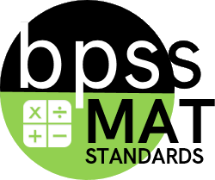Seventh Grade Math
Book |
MAT-07 "I can ... statements" |
||||
 |
(RP) | (NS) | (EE) | (G) | (SP) |
| Ratios Proportional Relationships |
The Number System |
Expressions and Equations |
Geometry |
Statistics and Probability |
|
| Prioritized Standards | |||||
|
Sixth Grade Math | Seventh Grade Math | Eighth Grade Math |
|||||
| Prioritized Standards |
MAT-07.EE.01
Student Learning Targets:Skills Domain (Performance) Targets
| ||||
MAT-07.EE.04
Student Learning Targets:Knowledge Targets
Reasoning Targets
Skills Domain (Performance) Targets
| ||||
MAT-07.EE.04.a
Student Learning Targets:Knowledge Targets
Reasoning Targets
Skills Domain (Performance) Targets
| ||||
MAT-07.G
Narrative for the (G) GeometryThe standards within the Geometry domain require students to (1) draw, construct, and describe geometrical figures and describe the relationship between them and (2) solve real-world and mathematical problems involving angle measure, area, surface area, and volume. Calculation Method for DomainsDomains are larger groups of related standards. The Domain Grade is a calculation of all the related standards. Click on the standard name below each Domain to access the learning targets and rubrics/ proficiency scales for individual standards within the domain. | |
MAT-07.G.01
| ||||||||||||
MAT-07.G.04
| ||||||||
MAT-07.G.06
Student Learning Targets:Knowledge Targets
Skills Domain (Performance) Targets
| ||||
MAT-07.NS
Narrative for the (NS) The Number SystemThe standards within the Number System domain require students to apply and extend previous understandings of operations with fractions to add, subtract, multiply, and divide rational numbers. Calculation Method for DomainsDomains are larger groups of related standards. The Domain Grade is a calculation of all the related standards. Click on the standard name below each Domain to access the learning targets and rubrics/ proficiency scales for individual standards within the domain. | |
MAT-07.NS.01
Student Learning Targets:Knowledge Targets
Reasoning Targets
Skills Domain (Performance) Targets
| ||||
MAT-07.NS.01.c
Student Learning Targets:Knowledge Targets
Skills Domain (Performance) Targets
| ||||
MAT-07.NS.01.d
Student Learning Targets:Skills Domain (Performance) Targets
| ||||
MAT-07.NS.02
Student Learning Targets:Skills Domain (Performance) Targets
WebsitesVocabularyInteger, Rational Numbers, Terminating Decimals, and Repeating Decimals. | ||||
MAT-07.NS.02.c
Student Learning Targets:Skills Domain (Performance) Targets
| ||||
MAT-07.NS.03
Student Learning Targets:Skills Domain (Performance) Targets
| ||||
MAT-07.RP
Narrative for (RP) Ratios and Proportional RelationshipsThe standards within the Ratios and Proportional Relationships Domain require students to analyze proportional relationships and use them to solve real world and mathematical problems. Calculation Method for DomainsDomains are larger groups of related standards. The Domain Grade is a calculation of all the related standards. Click on the standard name below each Domain to access the learning targets and rubrics/ proficiency scales for individual standards within the domain. | |
MAT-07.RP.01
Student Learning Targets:Knowledge Targets
Reasoning Targets
Skills Domain (Performance) Targets
| ||||
MAT-07.RP.02
Student Learning Targets:Knowledge Targets
Reasoning Targets
Proficiency ScaleResourcesWebsites
Vocabulary
| ||||
MAT-07.RP.02.a
Student Learning Targets:Reasoning Targets
ResourcesWebsites
Vocabulary
| ||||
MAT-07.RP.02.b
Student Learning Targets:Knowledge Targets
Reasoning Targets
Websites
Vocabulary
| ||||
MAT-07.RP.03
Student Learning Targets:Knowledge Targets
Reasoning Targets
Proficiency ScaleResourcesWebsites
Vocabulary
| ||||
MAT-07.SP
Narrative for the (SP) Statistics and ProbabilityThe standards within the Statistics and Probability domain require students to (1) use random sampling to draw inferences about a population, (2) draw informal comparative inferences about two populations, and (3) investigate chance processes and develop, use, and evaluate probability models. Calculation Method for DomainsDomains are larger groups of related standards. The Domain Grade is a calculation of all the related standards. Click on the standard name below each Domain to access the learning targets and rubrics/ proficiency scales for individual standards within the domain. | |
MAT-07.SP.07
Student Learning Targets:Reasoning Targets
Skills Domain (Performance) Targets
| ||||

 Domain (EE)
Domain (EE) Domain (G)
Domain (G) Domain (NS)
Domain (NS) Domain (RP)
Domain (RP) Domain (SP)
Domain (SP)